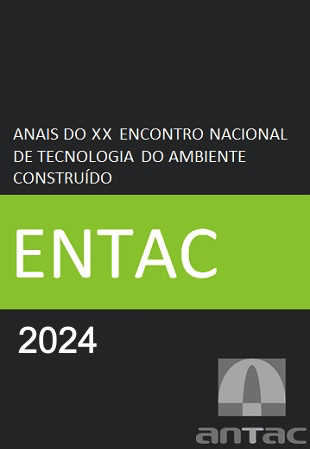Application of material passport to the wood frame constructive system using Revit
DOI:
https://doi.org/10.46421/entac.v20i1.6071Keywords:
Circular economy, Material passport, Built environment, Wood frame, RevitAbstract
The construction industry is responsible for one-third of greenhouse gas emissions, it consumes over 50% of the planet's natural resources, and its demand for natural resources is expected to increase with population growth. Against this backdrop, where business models are based on the Linear Economy (LE), the Circular Economy (CE) emerges as a strategy promoting economic development that reduces dependence on the consumption of natural resources. Thus, tools like Material Passports (MP) are necessary for the transition from LE to CE. The MP is a digital tool containing data and information describing material characteristics for its recovery and reuse. This study aims to model the MP of a wood frame panel commercially used by the company Tecverde in Paraná and it was designed for a building through the Revit software. The MP has 49 parameters divided into nine categories and the data were collected from open databases provided by the company. The result shows that there are still obstacles in relation to sustainability parameters, as well as opportunities to add circular values in the construction industry.
References
MUNARO, M. R.; TAVARES, S. F. Materials passport’s review: challenges and opportunities toward a circular economy building sector. Built Environment Project and Asset Management, v. 11, n. 4, p. 767–782, 21 out. 2021. Disponível em: https://doi.org/10.1108/BEPAM-02-2020-0027. Acesso em: 4/5/2024.
ARUP; ELLEN MACARTHUR FOUNDATION (EMF). From Principles to Practices: First Steps Towards a Circular Built Environment. 2018. Disponível em: Acesso em: 6/5/2024.
DEFRA. Digest of Waste and Resource Statistics. 2015. Disponível em: . Acesso em: 3/5/2024.
IRP. International Resource Panel, Bringezu, S., Ramaswami, A., Schandl, H., O'Brien, M., Pelton, R. E., & Nagpure, A. S. (2017). Assessing Global Resource Use: A systems approach to resource efficiency and pollution reduction. United Nations Environment Programme. Disponível em: <http://www.resourcepanel.org/reports/assessing-global-resource-use> Acesso em: 3/5/2024.
ARUP. The Circular Economy in the Built Environment. 2016. Disponível em: <https://www.arup.com/-/media/arup/files/publications/c/arup_circulareconomy_builtenvironment.pdf>. Acesso em: 3/5/2024.
EMF. Towards a circular economy: Business rationale for an acellerated transition. 2015. Disponível em: <https://www.ellenmacarthurfoundation.org/towards-a-circular-economy-business-rationale-for-an-accelerated-transition>. Acesso em: 20/4/2024.
LUSCUERE, L. M. Materials Passports: Optimising value recovery from materials. Proceedings of Institution of Civil Engineers: Waste and Resource Management, v. 170, n. 1, p. 25–28, 2017.
MUNARO, M. R.; TAVARES, S. F.; BRAGANÇA, L. Towards circular and more sustainable buildings: A systematic literature review on the circular economy in the built environment. Journal of Cleaner Production, v. 260, 2020.
BOKKINGA, D. I. The influence of a material passport on the value of real estate within the circular built environment. 2018.
MULHALL, D. et al. 2 Deliverable 5 lead partner: EPEA Nederland BV Report development: EPEA Nederland BV and SundaHus i Linköping AB. Disponível em: <https://www.bamb2020.eu/wp-content/uploads/2018/01/Framework-for-Materials-Passports-for-the-webb.pdf>. Acesso em: 22/4/2024.
AGUIAR, A.; VONK, R.; KAMP, F. BIM and Circular Design. IOP Conference Series: Earth and Environmental Science. Anais.2019. Disponível em: <https://www.scopus.com/ inward/record.uri?eid=2-s2.0-85063400559&doi=10.1088%2f1755-1315%2f225%2f1 %2f012068&partnerID=40&md5=17b34c562ab510ba700a07e71eaad327> Acesso em: 4/5/2024.
NIBS. An official publication of the National BIM Standard (NBIMS) and the National Institute of Building Sciences (NIBS) Journal of Building Information Modeling. JBIM. 2007.
TALLA, A.; MCILWAINE, S. Industry 4.0 and the circular economy: using design-stage digital technology to reduce construction waste. Smart and Sustainable Built Environment, v. 13, n. 1, p. 179–198, 2 jan. 2024.
SCHÜTZENHOFER, S.; HONIC, M.; KOVACIC, I. Design Optimisation via BIM Supported Material Passports. Proceedings of the International Conference on Education and Research in Computer Aided Architectural Design in Europe. Anais. 2020. Disponível em: <https://www.scopus.com/inward/record.uri?eid=2-s2.0-85119330389&partnerID= 40&md5=15a59b09df3899d00881ae2a6a3e1183> Acesso em: 25/4/2024.
HAO, J. L. et al. Carbon emission reduction in prefabrication construction during materialization stage: A BIM-based life-cycle assessment approach. Science of the Total Environment, v. 723, 25 jun. 2020.
HONIC, M. et al. Material Passports for the end-of-life stage of buildings: Challenges and potentials. Journal of Cleaner Production, v. 319, p. 128702, 2021a.
HONIC, M.; KOVACIC, I.; RECHBERGER, H. Concept for a BIM-based Material Passport for buildings. IOP Conference Series: Earth and Environmental Science. Anais. Institute of Physics Publishing, 25 fev. 2019.
HONIC, M. et al. Material Passports for the end-of-life stage of buildings: Challenges and potentials. Journal of Cleaner Production, v. 319, p. 128702, 2021b.
ATTA, I.; BAKHOUM, E. S.; MARZOUK, M. M. Digitizing material passport for sustainable construction projects using BIM. Journal of Building Engineering, v. 43, 1 nov. 2021.
SANCHEZ, B. et al. Augmenting materials passports to support disassembly planning based on building information modelling standards. Journal of Building Engineering, p. 109083, mar. 2024.
XIA, J.; XU, X. Construction Data Connectivity - A New Zealand Perspective and an Environmental Focus. IEEE International Conference on Automation Science and Engineering. Anais. IEEE Computer Society, 2023.
LI, Q.; WANG, Y. Blockchain’s role in supporting circular supply chains in the built environment. Proceedings - 2021 IEEE International Conference on Blockchain, Blockchain 2021. Anais. 2021. Disponível em: <https://www.scopus.com/inward/record .uri?eid=2-s2.0-85125642515&doi=10.1109%2fBlockchain53845.2021.00087&partnerID =40&md5=49b4a6f0f5c59173a0b80eebb5bf9a16> Acesso em: 3/5/2024.
WANDIGA, C. A. Methodological review: Socio-cultural analysis criteria for BIM modeling and material passport tracking of agriwaste as a building construction raw material. MRS Energy and Sustainability, v. 7, n. 1, 2020.
SANTOS, R. et al. Informetric analysis and review of literature on the role of BIM in sustainable construction. Automation in Construction. Elsevier B.V. 1 jul. 2019.
MUNARO, M. R. et al. Proposal of a building material passport and its application feasibility to the wood frame constructive system in Brazil. IOP Conference Series: Earth and Environmental Science. Anais. Institute of Physics Publishing, 25 fev. 2019.
ALVES, G. F. Passaporte de materiais a partir de modelagem da informação da construção: Aplicação utilizando Revit e Dynamo. Curitiba. Dissertação, Programa de Pós Graduação em Engenharia Civil. UFPR.. 2023.
Autodesk Support. Parameter of the material is not visible after exporting model to IFC from Revit. 17 de Janeiro de 2024. Disponível em: <https://www.autodesk.com.br /support/technical/article/caas/sfdcarticles/sfdcarticles/PTB/Parameter-of-the-material-is-not-visible-after-exporting-model-to-IFC-from-Revit.html> Acesso em: 11/05/2024.

